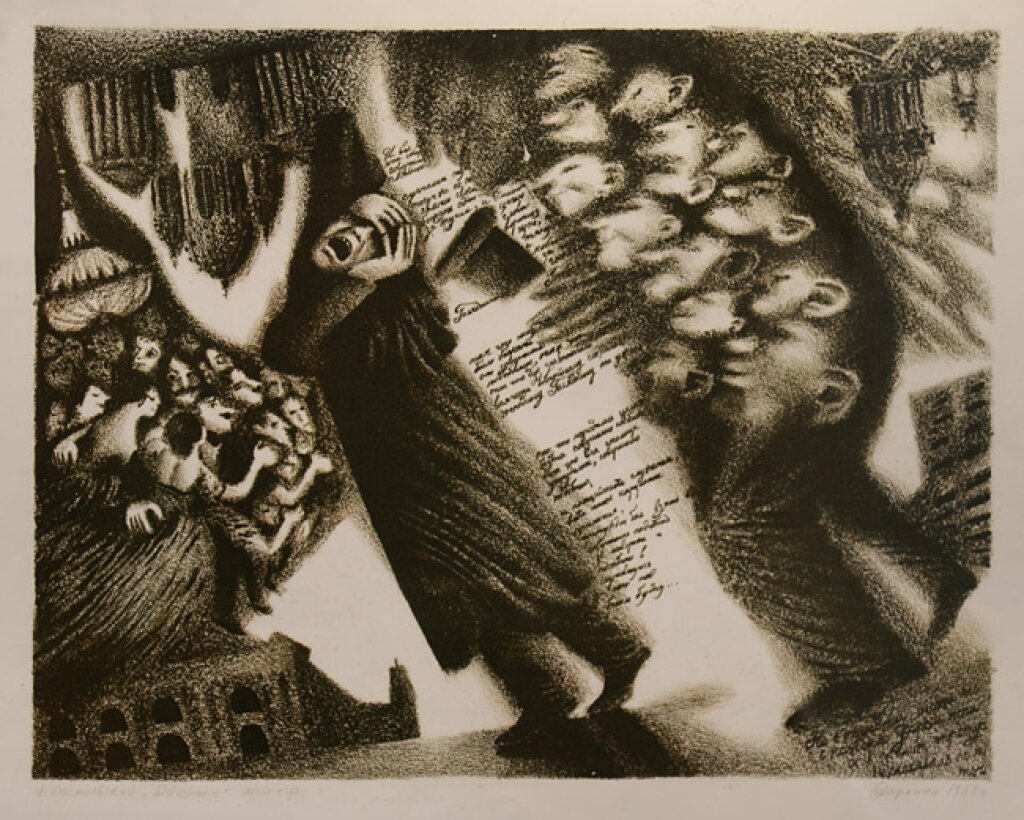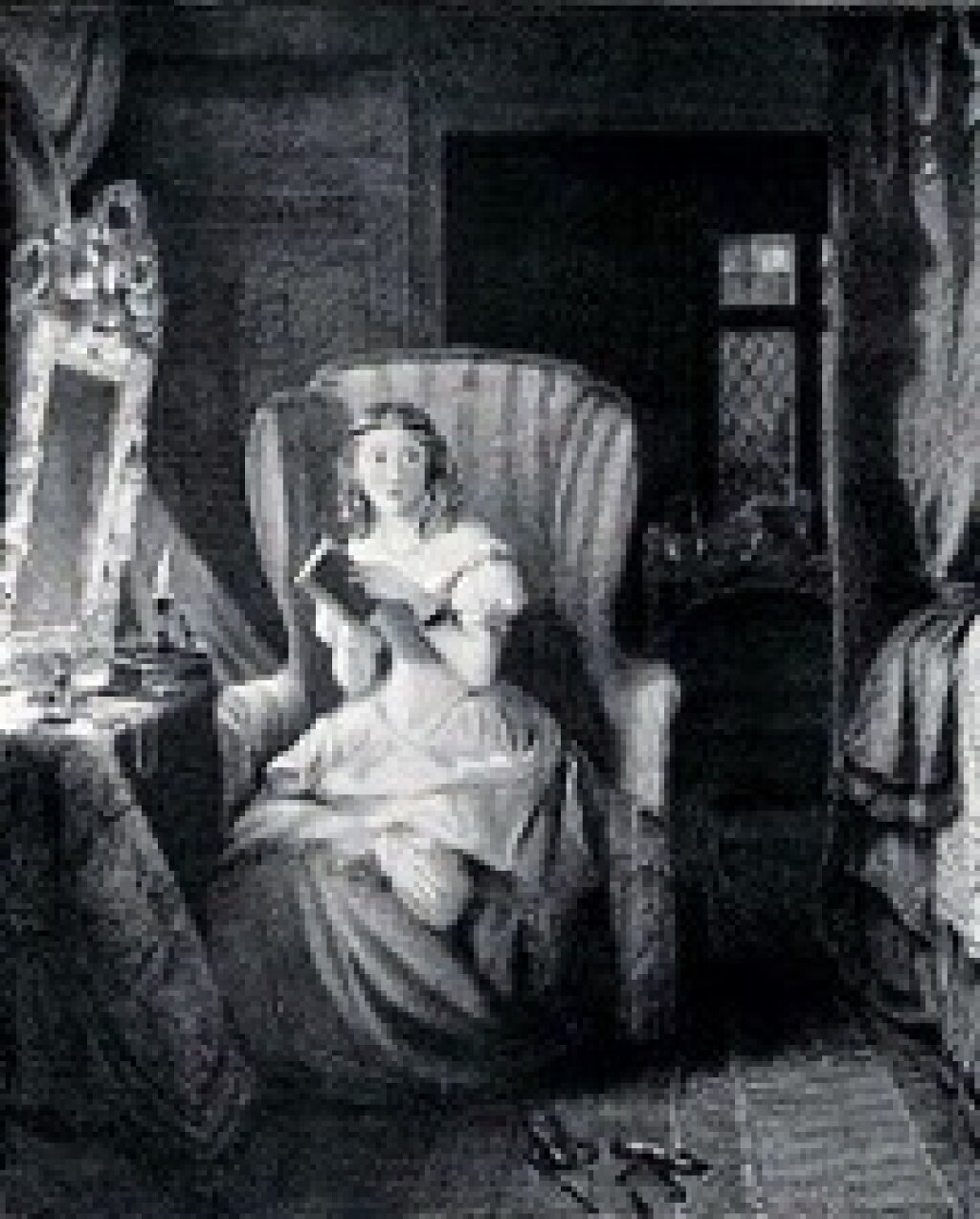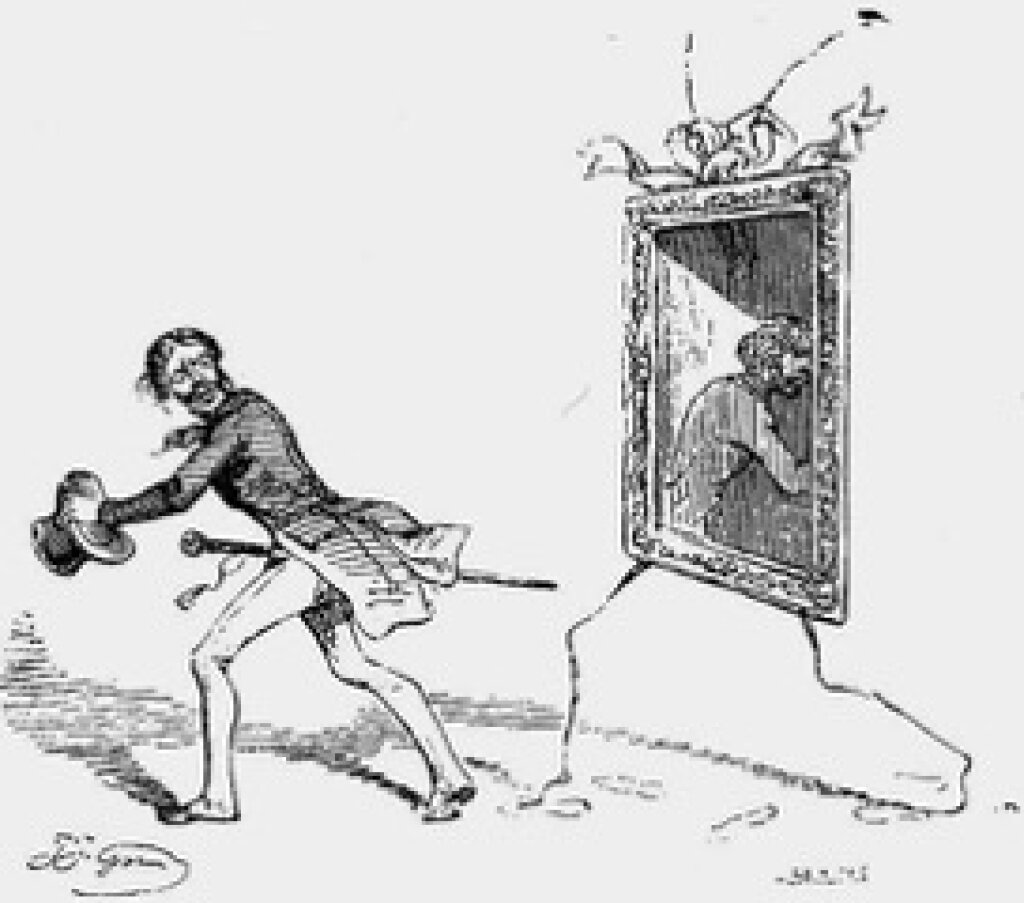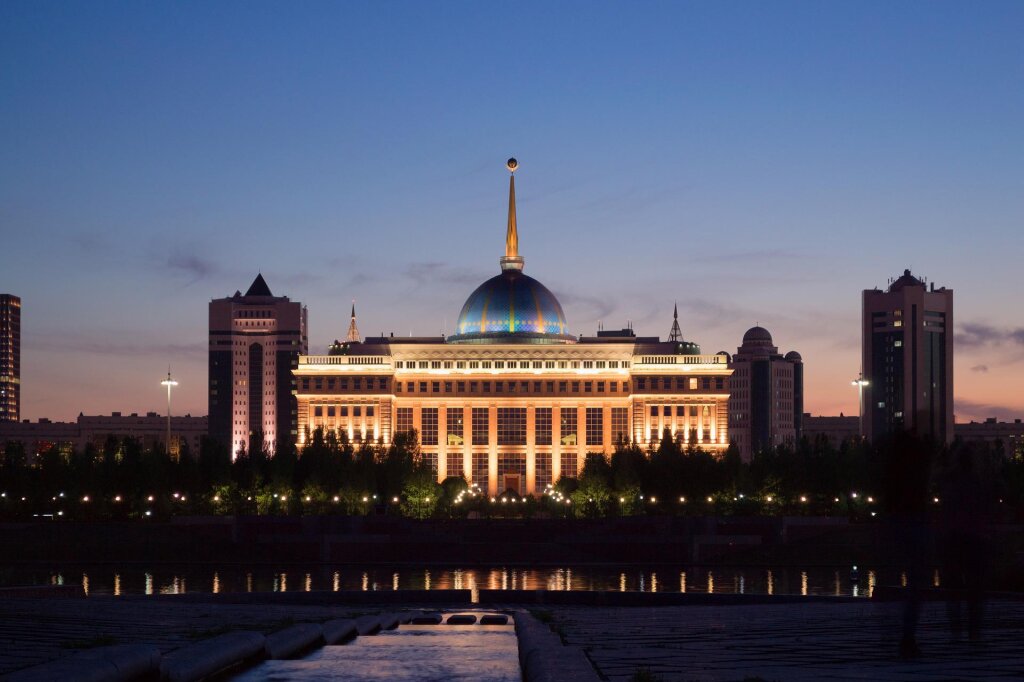Katherine Bowers is Assistant Professor of Slavic Studies at the University of British Columbia
{This is the second in a series of posts about Dostoevsky's The Double and its afterlife in film. The first one can be found here.)
As the bells begin to toll the midnight hour, Mr. Golyadkin is crossing the Fontanka in a terrible storm. St. Petersburg comes alive: black waters rise up against the embankments and howling winds gust through the streets. This soundscape also includes piercing squeaks from rattling lanterns and a gurgling backdrop from the heavy rain. Even this rain is ominous, “cutting and stinging Mr. Golyadkin in the face like a thousand pins” (138).[1] He is alone; a feeling of “inexplicable uneasiness” (139) comes over him. Trudging through the darkness, Golyadkin experiences a strange new sensation: “melancholy, yet not melancholy, fear, and yet not fear… a feverish trembling [runs] through his veins. The moment [is] unbearably unpleasant!” (140). All of a sudden, in this damp, dark, misty night, Golyadkin comes face to face with his double! A cold shiver runs down his spine, as he stands, senselessly staring after the other. “Have I gone mad or something?” (141) he asks himself, incredulously.
This episode from Chapter 5 of Fyodor Dostoevsky’s The Double features all the conventions of a derivative gothic scene: the stroke of midnight, a persecuted hero, stormy weather, isolation, and a sense of “inexplicable uneasiness.” Yet, even before Golyadkin, Jr. (that is, the double) appears, Golyadkin, Sr. is filled with anxiety, fear, and dread, almost as though the appearance of his double is expected. Throughout the work, Golyadkin Sr. repeatedly asks himself if he is hallucinating or going mad. By the end, though, he seems resigned to the existence of his double. In addition to this episode and the uncanny double, gothic psychologies such as anxiety, uneasiness, and dread permeate the work. While these could simply provide atmosphere, Dostoevsky exploits them to build up a palpable sense of anxiety for his reader, a reflection of his hero’s anxiety. While the narrator’s voice at times provides humor, the text’s gothic quality contributes to a sense of disquiet that lingers even after the book has been shut.
Dostoevsky was well aware of the power of the gothic. Indeed, gothic themes appear so frequently in his works that Vladimir Nabokov dismissed him as merely “a much overrated, sentimental, and Gothic novelist of the time.”[2] Intriguingly, Nabokov also considered The Double, despite its obvious gothic theme, to be “the very best thing [Dostoevsky] ever wrote.”[3] Dostoevsky’s interest in gothic fiction began when his parents read it to him as a child; he recalls that his hair “[standing] on end” and “raving deliriously in his sleep afterwards.”[4] He was familiar with works by British gothic writers including Clara Reeve, Ann Radcliffe, Matthew Lewis, and Charles Maturin, among others.[5] While these novelists are known for their formulaic writing, they produced enduringly popular fiction providing suspense and psychological thrills. The appeal of gothic fiction is its preoccupation with dark alter egos and passions, transgressive thoughts that lurk behind the seemingly rational mind and emerge in ways that expose hidden fears and truths. If the work’s links to the gothic are so readily apparent, the question remains: what do we gain from reading The Double gothically?
Gothic Doubling
The figure of the double or doppelgänger is a gothic stock character, one that David Punter classifies alongside Frankenstein’s creature, the Wandering Jew, and the Byronic vampire.[6] Each of these types can be read as the manifestation of anxiety over a transgression. Frankenstein’s creature exists because of his creator’s hubris, a man playing God. The Wandering Jew has been cursed with deathless wandering because of his sin against Christ. Vampires are undead, have forfeited their souls, and carry an illicit sexual connotation, particularly the Byronic variety. Punter uses the examples of Robert Louis Stevenson’s The Strange Case of Dr. Jekyll and Mr. Hyde (1886) and Oscar Wilde’s The Picture of Dorian Gray (1890) to showcase the double type. In both cases, the double figures—the violent, monstrous Hyde and Dorian’s decaying, aging portrait-self—reveal the horrors apparent when the self is physically divided. Jekyll’s goodness is offset by Hyde’s murderous tendencies just as Dorian’s external beauty contrasts with the internal decay and degeneration represented in his portrait.
The double’s appearance is usually terrifying because it is the manifestation of the social encounter feared most: one in which the authentic self is revealed. Suddenly, faced with your own mirror image, dark secrets are no longer buried, but potentially on display; if you can observe them, so can others. The terror lies in your double revealing your own hidden, true self, perhaps, even worse, a self hidden even to you. Analyzing E. T. A. Hoffmann’s “Der Sandmann” in “Das Unheimliche” (1919), Freud describes the sensation of uncanny, or unheimlich (literally, un-home-ly; a sense of feeling displaced from what’s familiar) as something not foreign, but strangely familiar, creating cognitive dissonance. He specifically uses the example of the doppelgänger in his discussion of the uncanny. Encountering your own double isn’t just a disturbing experience, but generates a peculiar kind of disquiet, one that comes from recognizing yourself but, at the same time, seeing yourself as others see you.
While the double’s appearance in Dostoevsky is horrifying, it isn’t violent, and the only murders that take place are metaphorical. In Wilde and Stevenson, the doubles represent a physical split, creating contradictory, opposing characters linked together. In Dostoevsky, the double plays a different role. At first, Golyadkin Sr. finds his double to be a friendly listener, but perceives that Golyadkin Jr. quickly begins to undermine him. Golyadkin Sr. believes he has righteousness on his side, but is ostracized in society. He observes that his double, on the other hand, is often hypocritical or deceitful, but his ability to perform within society’s expectations endears him to Golyadkin Sr.’s acquaintances. Golyadkin Sr. knows Jr.’s antics are rooted in falsehood, but, at the same time, the petty nastiness of Golyadkin Jr. is a mirror of Golyadkin Sr.’s rude treatment of his servant, Petrushka. Although Golyadkin Sr. considers his relationship with his double to be a dichotomy between authenticity and falseness, the reader realizes that all is falseness, that Golyadkins Jr. and Sr. are the same. Gary Saul Morson asserts that the novel’s humor lies in the fact that Golyadkin concurrently recognizes and refuses to recognize that he is his own double, while the horror of the piece lies in the possibility that “the real me is not mine but his, and I am the one who does not have a me!”[7] Or, rather, that an authentic self may not exist at all, just copies.
Golyadkin’s frequently expressed death wish—for example, “Mr. Golyadkin now not only wished to flee from himself, but also to be completely annihilated” (139)—comes to pass upon encountering the double and, with this, uncertainty about his own genuine existence. Strangely, throughout the text, Golyadkin dies multiple times, always metaphorically and often ironically. He’s described as half-dead, nearly dead, dead, annihilated, murdered, and, in one humorous line, Andrey Filippovich, Golyadkin’s head of office, shoots him a look “that would have destroyed our hero completely, had he not been completely destroyed already” (134). Similarly, the narrator describes Golyadkin after his humiliation at Klara Olsufyevna’s birthday party as though he has died: “Mr. Golyadkin had been murdered – murdered in the full sense of the word” (138). As Malcolm Jones points out, in this moment, Golyadkin “feels the physical abyss of the staircase looming up together with the spiritual abyss of total annihilation.”[8] In this state, he rushes out into the night and encounters his double for the first time.
In Dostoevsky’s text, the double appears after a metaphorical death. This progression is a mirror image of a common nineteenth-century spiritualist belief about doppelgängers, that the double’s appearance is an ill omen that often prefigures death. The reasoning behind this, taken from folklore, is that the spirit world and the living world co-exist, always hidden from each other, but before death, the barrier between them opens. For example, in Prometheus Unbound (1820), Percy Bysshe Shelley describes the priest Zoroaster encountering his own double, an apparition from the shadow world visible only to him. The double is a mirrored reflection of the living individual in the land of the dead; it appears to its other half in life just before death comes. This idea is not limited to literature; intriguingly, after Shelley’s death, his wife, the gothic novelist Mary Shelley, wrote in a letter that her husband had described seeing his own double less than a month before he died.[9] In inverting this formula, Dostoevsky creates more confusion around his text’s narrative structure. The double appears, but Golyadkin’s own state—living, dead, dreaming, mad—can only be guessed, leaving the reader in an uneasy state.
In 1848, Catherine Crowe published a two-volume parapsychological study called The Night-Side of Nature: Ghosts and Ghost-Seers, which includes chapters dedicated to diverse spectral phenomena including waking dreams, wraiths, apparitions, and “Doppelgängers, or Doubles,” among others. Crowe’s research documents a number of cases in which individuals encountered doubles, either their own or those of a friend or relative. In some of the cases, the double’s appearance did portend death. In others, apparently taken from doctors’ records, the double’s appearance is the result of illness, either mental or physical. The uncanny appearance of a double is usually upsetting, but some of the stories Crowe recounts strike me as humorous. For example, in one case, a Danish physician became very anxious about being held up on a call and missing a scheduled visit to another patient. However, afterwards, the unvisited patient reported that the physician had paid him a call. According to Crowe, hearing of his own spectral visits “occasioned him such an unpleasant sensation that he requested his patients never to tell him when it happened.”[10] In another instance, more in keeping with the focus of this blog, Crowe alludes to Catherine the Great, who allegedly had a more volatile reaction to her Doppelgänger: upon meeting her double sitting on her throne, she casually ordered her guards to fire upon it![11]
Crowe’s “Doppelgängers, or Doubles” chapter provides a strangely complementary read alongside Dostoevsky’s The Double. Beyond the fact that nearly all the doctors whose records Crowe cites are German (reminding me of Dr. Rutenshpitz), the two works appeared around the same time, although Crowe, living in England, wouldn’t have had any opportunity to read Dostoevsky’s novella before penning her study. Curiously, Golyadkin and Crowe share an experience: both were carted off to the madhouse at the end of their texts; Crowe was admitted to an asylum in 1854 after she was discovered wandering around Edinburgh naked because, she reported, spirits had told her to do so.[12] Crowe, afterwards, said that her madness was a research-based aberration as she had fallen into a state in which she believed “spirits were directing” her writing.[13]
Crowe was an enthusiast of German ghost stories, and many of the case studies described sound as if they are lifted from gothic novels, or echo Golyadkin’s encounter with his double. This resonance underscores Dostoevsky’s debt in his original formulation of The Double to E. T. A. Hoffmann, the German master of the uncanny Romantic tale. The Double’s direct influence from Hoffmann and his indirect influence filtered through Gogol is difficult to untangle. However, from Dostoevsky’s 1861 piece in Time comparing Edgar Allan Poe and Hoffmann, we learn that Dostoevsky admired Hoffmann’s ability to delve into the secrets of the psyche using a Romantic blend of fantasy and reality.[14] Crowe’s ghost stories seem reminiscent of this type of writing in that they, too, sit at the intersection between the imagined and the real. In another of Crowe’s cases, a man, “in perfect health, one evening, on turning the corner of a street, met his own form, face to face; the figure seemed as real and life-like as himself; and he was so close as to look into its very eyes. He was seized with terror, and it vanished.”[15] The man tells friends about it, tries to laugh it off, but remains shaken. Similarly, confronted with his own double, Golyadkin seeks reassurances from his colleagues that the similarity is uncanny, but no one else notices that anything is wrong. Crowe, writing a scholarly book, asserts throughout her study that she is seeking only the truth in her explorations. Golyadkin, too, champions authenticity, but Dostoevsky, writing his fantastic realist novella, knows he is crafting a fictional world, and problematizes Golyadkin’s quest for truth.
The Double, Gothically
The Double haunted Dostoevsky. It was critically panned upon publication in Notes of the Fatherland in 1846. He came back to it, again and again, eventually publishing a revised version in 1866 (the one commonly read today). But even after this, the novella continued to obsess him. In 1877, he wrote in the Writer’s Diary, “I failed with this novella, but the idea was fairly luminous, and I have never done anything in literature more serious than this idea. But the form I gave to this novella was a complete failure… and if now I were to come back to this idea to develop it again, I should choose a completely different form: but in 1846 I was not able to find that form.”[16]
Dostoevsky’s conclusion that the novella’s form didn’t work leads us back to the gothic. The Double is a novel that starts naturalistically, detailing Golyadkin’s various thoughts as he goes through his day. At midnight, he encounters his double in a gothic scene, and is terrified. Afterwards, the double torments him, but we don’t know if the double is a hallucination, an apparition, or a physical person. Finally, the novella ends with Golyadkin on the way to some kind of asylum. The gothic scene in Chapter 5 is the key threshold scene between the naturalistic opening and the fantastic potential of the conclusion. This gothic scene could be a continuation of the naturalism, a nod to Golyadkin’s increasing paranoia and anxiety. It could be the beginning of the fantastic portion, a midnight transition into a Petersburg in which reality blurs and cannot be trusted. But the gothic scene is entirely subjective: no one thinks the double’s appearance is fantastic except Golyadkin and potentially the reader.
The section in which the double appears links two transitional gothic moments: Golyadkin’s midnight bridge crossing and the final moment, as Golyadkin finds himself enroute to the asylum. Some critics read The Double as a nightmare, and these linked scenes are key to that reading, especially the specific Petersburg environment that contextualizes the initial appearance of the double.[17] Donald Fanger equates the atmosphere of Petersburg as that of a bad dream,[18] tying this particular scene specifically to the city’s layered mythology, a point that becomes particularly relevant in the context of both Dostoevsky’s subtitle of the novella, “A Petersburg Poem,” and its relationship to Pushkin’s earlier work “The Bronze Horseman” (1833). In that poema, the city literally comes to life in another sequence that’s not clearly identified as waking or dreaming, when the Falconet monument to Peter the Great chases hapless clerk Evgeny through the dark, flooding streets of Petersburg, eventually sending him to madness and death. Konstantin Mochulsky even says that Golyadkin himself is “an outgrowth of the putrid Petersburg fog, a phantom living in a phantom city.”[19] Going a step further, Dina Khapaeva argues that the entire text, not just selected episodes, is an expression of nightmare.[20]
But, for a nightmarish text with a gothic core, The Double is remarkably humorous. Golyadkin’s anxious thoughts seem awkward to us, but are endearing as well. The narrator’s often mocking voice amuses, and even though Golyadkin is filled with horror, annihilated, crushed, it seems excessively melodramatic, to the point of laughter. When the narrator states things like, “The man now sitting across from Mr. Golyadkin was Mr. Golyadkin’s horror, he was Mr. Golyadkin’s shame, he was Mr. Golyadkin’s nightmare from the day before; in short, he was Mr. Golyadkin, himself” (146), horror combines with laughter to create a layered text that leaves the reader with still more questions. Malcolm Jones identifies a chorus of voices in the novella, but states that the voice of “reality” is lacking. There are threshold positions, like the gothic scene in Chapter 5, in which “reality and fantasy are delicately poised,” but “it is impossible … to discern where the threshold lies. The text passes over into a permanently confused state and takes the reader with it.”[21]
Jones’s Bakhtinian reading of The Double resonates with the narration found in one of Dostoevsky’s favorite gothic novels, Maturin’s Melmoth the Wanderer (1820). There, the reader can rely on the narrator, but the manuscript itself is not reliable. The narrated story frames a fractured tale taken from a book that is literally disintegrating: “dissolved, obliterated, and mutilated beyond any that had ever before exercised the patience of a reader.”[22] At times, the text from this manuscript breaks off, allowing the voice of a second narrator to enter. The second narrator, coming in abruptly, does not contextualize, but instead plunges the reader into an often disconnected and mysterious tale. The end result of this is a book filled with twists and turns that are not logically mappable, with voices that don’t respond to each other, and with great confusion as to what’s actually happening on the part of the reader, who becomes a refraction of the reader squinting through the damaged manuscript within the novel.
The reader of The Double feels a similar sense of confusion, as s/he struggles with the novella’s great puzzle: whether or not the double is real. Does Golyadkin’s mental distress cause him to hallucinate the double, or is the double perhaps one manifestation of a split personality, a variation of heautoscopy? Or, is the double’s appearance a fantastic element that, in the gothic tradition of Horace Walpole, Matthew Lewis, and Charles Maturin, has no explanation? Or, is the novella simply Golyadkin’s nightmare? The text offers no definitive answers. It is this intermingling of possible explanations—and the lack of resolution—that gives The Double one facet of its permeating gothic feel. For, in The Double, the reader is as disconnected from the truth of the matter as the hero.
The final scene of The Double sees the hero in a carriage, seated across from Dr. Rutenshpitz… or the doctor’s double… described simply as: “two burning eyes staring at [Golyadkin] in the dark, shining with a sinister, infernal glee” (229). Up to this point, Golyadkin’s monster has been his duplicate, but in this scene, we can’t help but think of Stephen King’s observation that “monsters… may pop up in our own mirrors—at any time.”[23] And this is the value of reading The Double gothically: the irresoluble nature of Dostoevsky’s novella allows the reader to make up his/her own mind about the text’s solution. It may be that this lack of resolution is intended to prompt readers to look at themselves in the mirror and imagine how they would react if they, struggling at midnight through a terrible storm, came across a stranger who looked exactly like them…
Notes
[1] All quotes from The Double are from Fedor Dostoevskii, Polnoe sobranie sochinenii v tridtsati tomakh, Vol. 1 (Leningrad: Nauka, 1972). Hereafter PSS. All translations are my own unless stated otherwise.
[2] Vladimir Nabokov, Eugene Onegin: A Novel in Verse, Vol. 2 (Princeton: Princeton University Press, 1991), 191.
[3] Nabokov, Lectures on Russian Literature (New York: Mariner Books, 2002), 90.
[4] Dostoevsky refers specifically to the novels of Ann Radcliffe in this passage. Dostoevskii, PSS, Vol. 5, 46.
[5] See Robin Feuer Miller, “Dostoevsky and the Tale of Terror,” in W. J. Leatherbarrow, ed., Dostoevskii and Britain (Oxford: Berg, 1995), 139-158.
[6] David Punter, The Literature of Terror. A History of Gothic Fictions from 1765 to the Present Day. Vol. 2. The Modern Gothic (Harlow: Pearson Education Limited, 1996), 21.
[7] Gary Saul Morson, “Me and My Double: Selfhood, Consciousness, and Empathy in The Double,” in Elizabeth Cheresh Allen, ed., Before they were Titans: Essays on the Early Works of Dostoevsky and Tolstoy (Boston: Academic Studies Press, 2015), 50.
[8] Malcolm Jones, Dostoyevsky after Bakhtin: Readings in Dostoyevsky’s Fantastic Realism (Cambridge: Cambridge University Press, 1990), 44.
[9] Betty T. Bennett, ed., The Letters of Mary Wollstonecraft Shelley, Vol. 1 (Baltimore: Johns Hopkins University Press, 1980), 245.
[10] Catherine Crowe, The Night-Side of Nature, or, Ghosts and Ghost-seers, Vol. 1 (London: T. C. Newby, 1848), 287.
[11] Ibid., 280. This story is widespread in popular accounts, but seems largely absent from scholarly ones. In Andrew Lang’s The Book of Dreams and Ghosts (1897), an eyewitness account is actually reproduced, albeit one acquired second hand long after the alleged episode.
[12] Dickens recounts the story of her madness in a letter to a friend. The Letters of Charles Dickens, Vol. 7 (Oxford: Clarendon, 1974-93), 285-286. Dickens called her case “hopeless,” but Crowe made a full recovery!
[13] Cited in Dickens, Vol. 7, 286.
[14] For a more thorough discussion, see Jacques Catteau, Dostoyevsky and the Process of Literary Creation (Cambridge: Cambridge University Press, 1989), 53-62.
[15] Crowe, 281.
[16] Quoted in Jacques Catteau, Dostoyevsky and the Process of Literary Creation (Cambridge: Cambridge University Press, 1989), 61.
[17] I have written elsewhere on gothic elements in early realist texts set in St. Petersburg, including several by Dostoevsky. See Katherine Bowers, “The City through a Glass, Darkly: Use of the Gothic in Early Russian Realism,” The Modern Language Review 108.4 (2013): 1199-1215.
[18] Donald Fanger, Dostoevsky and Romantic Realism: A Study of Dostoevsky in Relation to Balzac, Dickens, and Gogol (Cambridge: Harvard University Press, 1967), 160-161.
[19] Quoted in Fanger, 161. From Konstantin Mochulsky, Dostoevsky: Zhizn’ i tvorchestvo (Paris, 1947), 42.
[20] See Dina Khapaeva, Nightmare: From Literary Experiments to Cultural Project (Amsterdam: Brill, 2013), 107-131.
[21] Jones, 58.
[22] Charles Maturin, Melmoth the Wanderer (Oxford: Oxford University Press, 1998), 28.
[23] Stephen King, Danse Macabre (New York: Berkley Books, 1983), 252.






